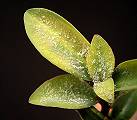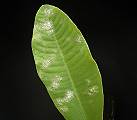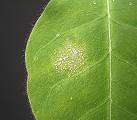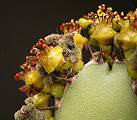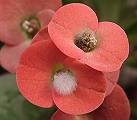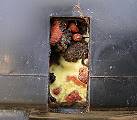

|
|
| About Euphorbiaceae
Pests and Diseases - Mildew and other fungal Diseases
|
Mildew appears as a white, powdery film on parts of the plant. The disease can be caused by too high humidity, insufficient ventilation, too little light, plants placed too close together, or low resistance to infection from lack of nutrients. So it follows that the best protection from mildew is improved cultural conditions.
If however mildew strikes, the infected plants must be immediately isolated, and in some cases the infected parts must be removed and destroyed. Regular cleaning of the infected parts can help, otherwise chemicals need to be used. As there is no specific fungicide on the market for mildew on euphorbias, you will need to choose one for mildew on roses or ornamentals.
One disadvantage of a systemic fungicide is that is cannot be used in the rest period when no water is being taken up by the plant. At these times contact fungicides need to be used such as sulphur or sulphur preparations, or sprays. Foot sprays against fungal infections are very effective and harmless to humans.
Some euphorbia species produce abundant nectar in the flowering season. If this is not collected by hover flies or other insects, mould can also develop on it. This does not directly damage the plant as it disappears as the nectar dries, but it can interfere with pollination. Untreated, the mould can recur every year in some plants. It can be dealt with in the same way as mildew. Finally, there are other types of fungi living in the soil which can spread and block air spaces. In this case depotting is the answer, cleaning the roots and repotting in fresh soil. Frequent applications of 1% Chinosol will also work.
Please read carefully the manufacturer’s safety instructions before using any chemicals.
Mildew |
||
Monadenium pseudoracemosum |
Monadenium pseudoracemosum |
Euphorbia guiengola |
Mold |
||
Euphorbia evansii |
Euphorbia milii hybr. |
|
Soil fungus |
|
View through a draining hole |
|
|
Corking Mealy Bugs Mildew and other fungal Diseases Red Spider Mites Root Mealy Bugs Root Rot Sciara Fly or Fungus Gnats Tip Die-Back Tobacco mosaic Virus White Fly |
